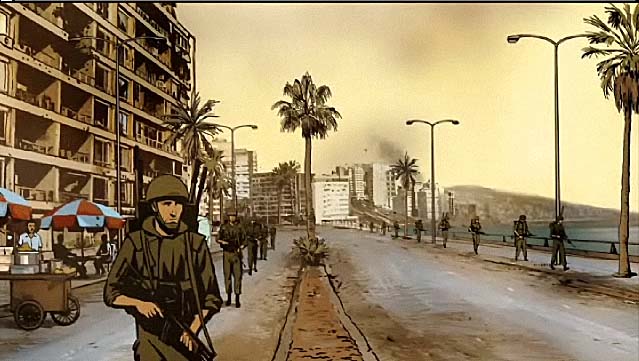
One of the movies that really struck me lately is Waltz with Bashir, Ari Folman’s animated account of his search to piece together some lost fragments from his memory, from the time that he was a soldier in Lebanon 25 years ago (leading up to the rememberance of his experience of the Sabra and Shatila Massacre). In fact, seeing this powerful film, considering its queries about the status of documents and film documentary, about the ethics of the image and the relation between media and memory, was one of guiding forces for putting together a new film program, Drawn to Life, which is partly about “animation” as “reanimation”, as a tool for revitalising history, memory and perception.
“How does one avoid overly aestheticizing violence when using animation?” asks Michael Koresky in Reverse Shot. “Despite a radical, unified look, the imagery in Waltz with Bashir ranges from the mundane to the dreamlike, and often those distinctions collapse, expand, and mutate right before our eyes. Folman isn’t gussying up a difficult chapter of history in accessible pop extravagance; rather he’s using a new form to investigate the terrible persistence, not to mention unreliability, of memory and perception, and how personal and political deceptions often go hand in hand.”

Here’s a few fragments from interviews with Folman, in which he talks about his reasons for using animation techniques (actually a specially designed combination of Flash animation, classic animation and 3D, so NO rotoscope animation. Each visual was made up of independently moving pieces) to deal with memory and trauma.
“WALTZ WITH BASHIR was always meant to be an animated documentary. For a few years, I had the basic idea for the film in my mind, but I was not happy at all to do it in real life video. How would that have looked like? A middleaged man being interviewed against a black background, telling stories that happened 25 years ago, without any archival footage to support them. Then I figured out it could be done only in animation with fantastic drawings. War is so surreal, and memory is so tricky that I thought I’d better go all along the memory journey with the help of very fine illustrators.”
“Using animation is like magic. You have freedom to go from one dimension to another pretty quickly, a freedom to move from the subconscious to the conscious, from dreams to memory and hallucinations and testimonies. (…) How do you depict a dream? You can write it down, which would be fairly accurate, but if you want to film it, you would have to have a set and actors,” he said. With animation, however, “you get rid of the ‘middle-man.’ And in some cases, you have a tool that is more truthful.”
“A journey trying to figure out a traumatic memory from the past is a commitment to long term therapy. My therapy lasted as long as the production of WALTZ WITH BASHIR: four years. There was a shift from dark depression as a result of things discovered to being in euphoria over the film finally being in production with complicated animation being done by the team at a pace better than expected. If I was the type of guy who believes in the cult of psychotherapy, I’d swear the film had done miracles to my personality. But due to previous experience, I’d say the filmmaking part was good, but the therapy aspect sucked.”
“I don’t care whether it is documentary or fiction. maybe it is the first animated documentary ever, but does it really matter? (…) The whole idea is that it was basically subjective memories, so there is no real or unreal.”
“I believe that there are thousands of Israeli ex-soldiers who keep their war memories deeply depressed. They might live the rest of their lives like that, without anything ever happening. But it could always burst out one day, causing who-knows-what to happen to them. That’s what Post-Traumatic Stress Disorder is all about.”

Folman is now working on an adaptation of Stanislaw Lem’s novel The Futurological Congress.